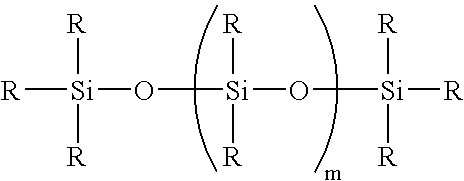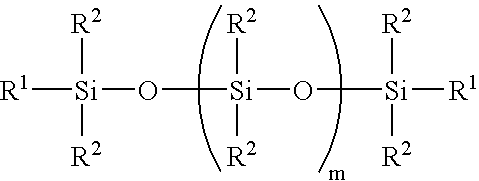Curable organopolysiloxane composition, use of the cured product of the composition, and semiconductor device
- Summary
- Abstract
- Description
- Claims
- Application Information
AI Technical Summary
Benefits of technology
Problems solved by technology
Method used
Image
Examples
reference example 1
[0057] 400 grams (g) 1,3-dimethyl-1,3-diphenyl-1,3-divinyldisiloxane was heated to 50.degree. C. and 55 g of an aqueous solution of chloroplatinic acid (platinum metal content=13 wt %) was added thereto in a dropwise manner, whereupon the mixture was subjected to agitation for 1 hour at 70.degree. C. After that, the mixture was cooled to room temperature and 55 g sodium hydrogencarbonate and 9 g calcium chloride were added thereto. After stirring the mixture, the produced salts were removed by filtration, yielding a platinum complex (I) consisting of a 1,3-dimethyl-1,3-diphenyl-1,3-divinyldisiloxane solution of a 1,3-dimethyl-1,3-diphenyl- 1,3-divinyldisiloxane complex of platinum.
reference example 2
[0058] With the exception of using 1,3-divinyltetramethyldisiloxane instead of the 1,3-dimethyl-1,3-diphenyl-1,3-divinyldisiloxane used in Reference Example 1, a platinum complex (II) consisting of a 1,3-divinyltetramethyldisiloxane solution of a 1,3-divinyltetramethyldisi-loxane complex of platinum was prepared in the same manner as in Reference Example 1.
APPLICATION EXAMPLE 1
[0059] A curable organopolysiloxane composition with a viscosity of 10,000 mPa.s was prepared by uniformly mixing 100 parts by weight of methylphenylpolysiloxane with a viscosity of 12,000 mPa.s having both ends of the molecular chain blocked by dimethylvinylsiloxy groups (content of silicon-bonded vinyl groups=0.20 wt %, ratio of silicon-bonded phenyl groups to all silicon-bonded organic groups: 49 mol %) as component (A), methylhydrogenpolysiloxane (content of silicon-bonded hydrogen atoms=1.0 wt %) with a viscosity of 1.5 mPa.s having both ends of the molecular chain blocked by trimethylsiloxy groups in the...
application example 1
[0062] The index of refraction and optical transmittance of the curable organopolysiloxane composition and its cured product were measured. The results are listed in Table 1. Additionally, photocouplers and LEDs were fabricated using the curable organopolysiloxane composition. The results of reliability evaluation of the semiconductor devices are listed in Table 1.
PUM
| Property | Measurement | Unit |
|---|---|---|
| Fraction | aaaaa | aaaaa |
| Transmittivity | aaaaa | aaaaa |
| Refraction | aaaaa | aaaaa |
Abstract
Description
Claims
Application Information
 Login to View More
Login to View More - R&D
- Intellectual Property
- Life Sciences
- Materials
- Tech Scout
- Unparalleled Data Quality
- Higher Quality Content
- 60% Fewer Hallucinations
Browse by: Latest US Patents, China's latest patents, Technical Efficacy Thesaurus, Application Domain, Technology Topic, Popular Technical Reports.
© 2025 PatSnap. All rights reserved.Legal|Privacy policy|Modern Slavery Act Transparency Statement|Sitemap|About US| Contact US: help@patsnap.com



